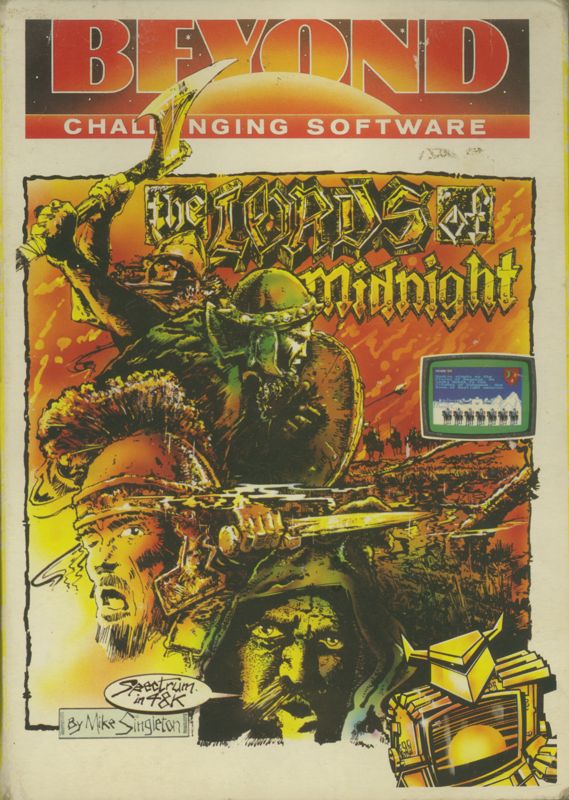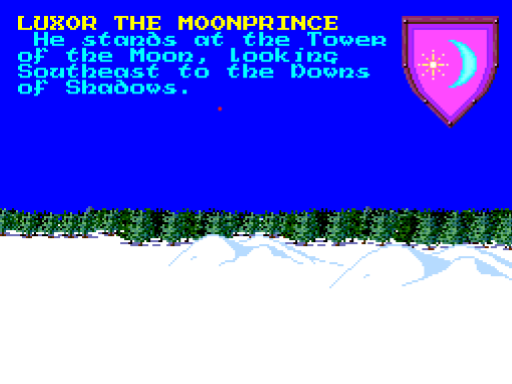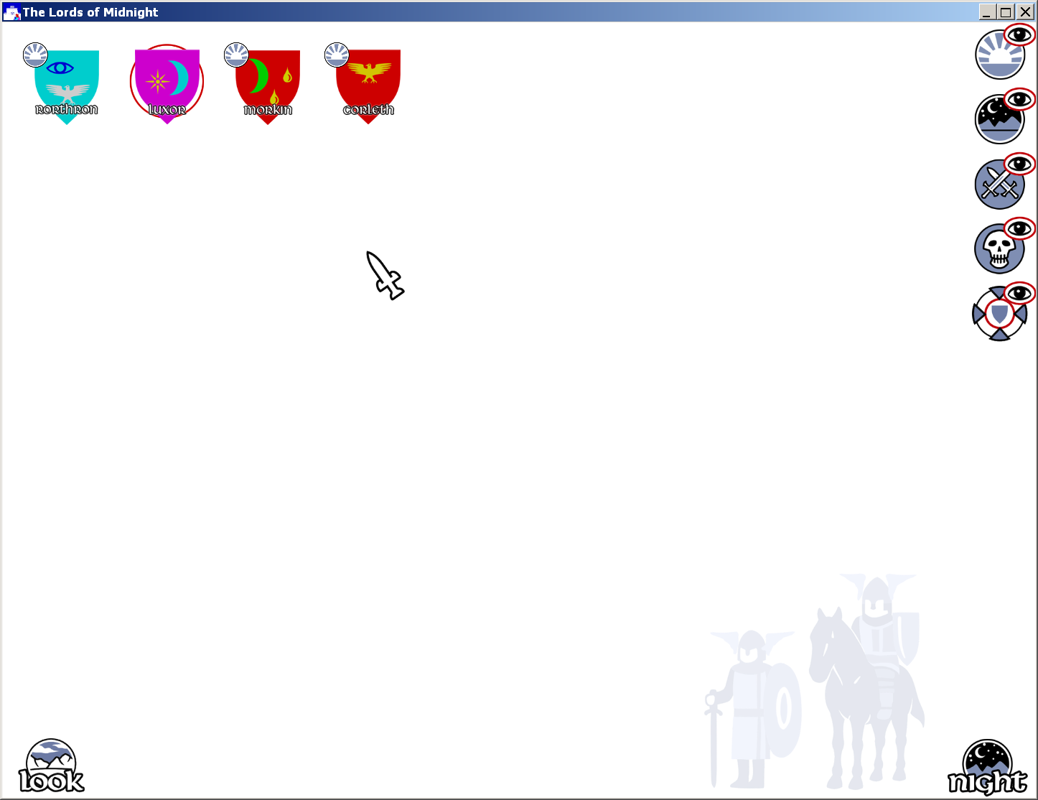Retro Replay Review
Gameplay
The Lords of Midnight unfolds as a unique hybrid of strategy and role-playing, offering players two distinct paths to victory. You begin with a small party consisting of Luxor the Moonprince, his son Morkin, Corleth the Fey, and Rothron the Wise, each boasting individual strengths and weaknesses. As you explore the vast landscape, you can recruit powerful allies like Lord Dreams, Lord Blood, and even the Utarg of Utarg. This recruitment mechanic ensures that no two playthroughs feel the same, as your warband’s composition directly influences your tactical options and narrative possibilities.
(HEY YOU!! We hope you enjoy! We try not to run ads. So basically, this is a very expensive hobby running this site. Please consider joining us for updates, forums, and more. Network w/ us to make some cash or friends while retro gaming, and you can win some free retro games for posting. Okay, carry on 👍)
The dual victory conditions add depth and replayability. You can choose the sweeping strategy route by defeating Doomdark’s armies in open battle, or you can embark on a daring solo quest: only Morkin can infiltrate the enemy’s territory and steal back the moon ring. The choice between large-scale warfare and a focused RPG-style mission encourages experimentation. Fans of grand strategy will relish coordinating multiple lords across 4,000 screens, while players who prefer intimate, character-driven adventures can pursue Morkin’s perilous heist under the cover of darkness.
Turn-based mechanics center around the cycle of day and night. During the day, you scout forests, plains, and keeps under the soft glow of the mountain moon; by night, Doomdark’s foul forces—including dragons, skulkrin, and wolves—advance relentlessly. Each “turn” gives you time to plan movements in all eight compass directions, unlocking up to 32,000 unique viewpoints. This staggering scope makes every decision feel monumental: should you press forward to recruit a distant ally, or fortify your current position against an encroaching horde?
Graphics
By modern standards, The Lords of Midnight’s visuals may appear minimalist, yet they remain remarkably evocative. On release platforms like the ZX Spectrum and Amstrad CPC, the game leveraged simple line art and monochrome shading to convey moody forests, frozen lakes, and towering keeps. Every screen feels like a hand-drawn tableau, inviting players to imagine the dark silhouettes of trees swaying beneath a crescent moon.
The engine’s ability to present 32,000 distinct views was a technical marvel of its time. Though each backdrop consists of basic black-and-white pixels, the subtle variations in tree shapes, mountain ridges, and body-of-water outlines give the map a sense of organic scale. There’s a particular charm in this simplicity: rather than overwhelming you with detail, the game sparks your imagination, allowing you to mentally fill in the gaps and feel truly immersed in Midnight’s ominous wilderness.
Animations are sparse but functional. Unit movement is represented by shifting markers on the map, and when battles occur, simple text prompts and symbols communicate success or failure. While this minimalist approach might not satisfy players accustomed to flashy cutscenes or high-resolution sprites, it’s purposeful: the graphics never distract from the deeper strategic and narrative layers. Instead, they provide a consistent, unassuming backdrop against which your epic struggle unfolds.
Story
The narrative thrust of The Lords of Midnight revolves around the tyrannical Doomdark, a malevolent presence seeking to envelop the realm in everlasting darkness. As Luxor the Moonprince and his allies rally medieval kingdoms and fey clans, you become the architect of a desperate resistance. The story’s open-ended structure means that lore snippets are often delivered through character recruitment messages and brief mission descriptions, letting you piece together Midnight’s history as you play.
Each recruitable lord comes with a touch of backstory: Lord Dreams once communed with the spirits of ancient forests, while Lord Blood is rumored to have been born in a crypt beneath the Iron Mountains. These bites of lore deepen your connection to the characters, making every decision—whether to risk a mountain pass or march through a haunted glade—feel loaded with narrative weight. If Luxor falls in battle, only Morkin remains, heightening the drama and underscoring the fragility of your cause.
Beyond the core struggle against Doomdark, the quest for the moon ring adds an extra layer of mythic resonance. The ring itself is said to be the source of Luxor’s celestial powers; its recovery by Morkin transforms the game into a tense, lone-wolf infiltration mission. This narrative twist reframes the conflict from a sweeping war to a personal journey of sacrifice and cunning, ensuring the story remains dynamic throughout.
Overall Experience
The Lords of Midnight stands as a testament to creative design overcoming technical limitations. Its blend of grand strategy, character-driven role-play, and dynamic day-night cycles creates a tapestry of gameplay that remains compelling decades after its initial release. Whether you’re meticulously coordinating dozens of lords in pitched battles or tiptoeing through enemy encampments under cover of darkness, the game continually delivers tension and satisfaction.
Replay value is exceptionally high. With multiple paths to victory, dozens of recruitable lords, and a sprawling map that rewards exploration, no two campaigns feel identical. The minimalist graphics and text-based events may feel dated to some, but they also encourage imagination—an element often lost in modern titles. You become an active participant in crafting the tale, rather than a passive viewer of pre-rendered scenes.
For players seeking an immersive strategic challenge steeped in mythic atmosphere, The Lords of Midnight remains a must-experience classic. It demands patience and thoughtful planning, rewarding those who invest time in learning its rhythms. Though its interface and presentation may appear archaic, the core experience—rallying an embattled realm against encroaching darkness—is as engrossing now as it was at its debut.
 Retro Replay Retro Replay gaming reviews, news, emulation, geek stuff and more!
Retro Replay Retro Replay gaming reviews, news, emulation, geek stuff and more!









Reviews
There are no reviews yet.